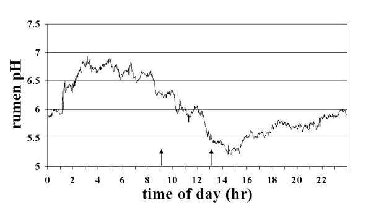Acidosis in Dairy Cows
One of the most prevalent metabolic diseases among dairy cows is subacute ruminal acidosis (SARA). Unfortunately it is also one of the more difficult to diagnose and prevent. The economic consequences of SARA are mind boggling. It has been estimated that the North American dairy industry loses between $500 million and $1 billion annually to SARA with a cost per affected cow of $1.40/day.
SARAThe pH (acidity) of rumen fluid is usually between 6.0 and 6.4. Rumen pH fluctuates during the day with drops usually associated with grain consumption (Figure 1).
| |
| Figure 1. Continuous rumen pH measurements from a holstein cow over one day. Arrows indicate times when a grain supplement was fed to experimentally simulate SARA. Source: Sub-Acute Ruminal Acidosis (SARA) in Dairy Cows. OMAF: 2003. | |
Dr. Karen Beauchemin of Agriculture and Agri-Food Canada defines acidosis as occurring when the rumen pH remains below 5.8 for more than 5 consecutive hours per day. Other dairy scientists state that a rumen pH of <5.5 is indicative of SARA. During normal digestion, the volatile fatty acids produced by grain breakdown are absorbed by the rumen papillae where they enter the bloodstream and are subsequently used as an energy source for milk production. The problem of SARA arises when the level of VFA in the rumen exceeds the ability of the animal to absorb the acids. They accumulate in the rumen and cause the pH to drop.
Symptoms of SARADecreased feed intake and erratic feed consumption patterns are the first signs of SARA in a herd. These symptoms will be easier to pick out in some herds than in others. For example, it may be difficult to pick out an affected cow in a group-fed situation. Close observation at feeding times is therefore important. Reduced feed intake will be associated with reduced cud-chewing and lower milk production. A milk fat depression may or may not occur. During bouts of SARA, fecal consistency becomes more fluid. Cows often experience laminitis. Longer term consequences of SARA include weight loss and poor body condition.
Diagnosing SARADetermining the pH of rumen fluid is the most accurate way of diagnosing SARA. However, obtaining rumen samples with a stomach tube will give inaccurate results due to contamination with saliva and its buffers. The recommended method of collection is rumenocentesis which can easily be done by a veterinarian. The best time to sample cows is 5-8 hours after feeding, if the feeding program is a TMR fed once daily, or 2-5 hours after concentrate feeding, if forage and concentrate are fed separately. Sample at least 10 cows, within 60 DIM, per feeding group. When 25% or more of the cows have a pH less than 5.5, the group can be considered to be suffering from SARA.
Preventing SARA
Nutrition Update Volume 14 No.3, February 2004 | |

